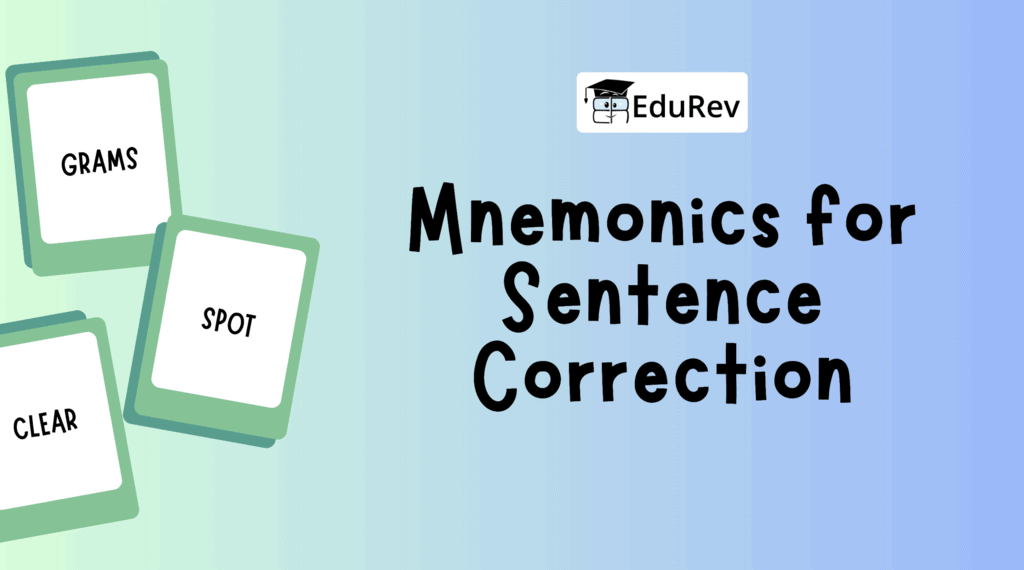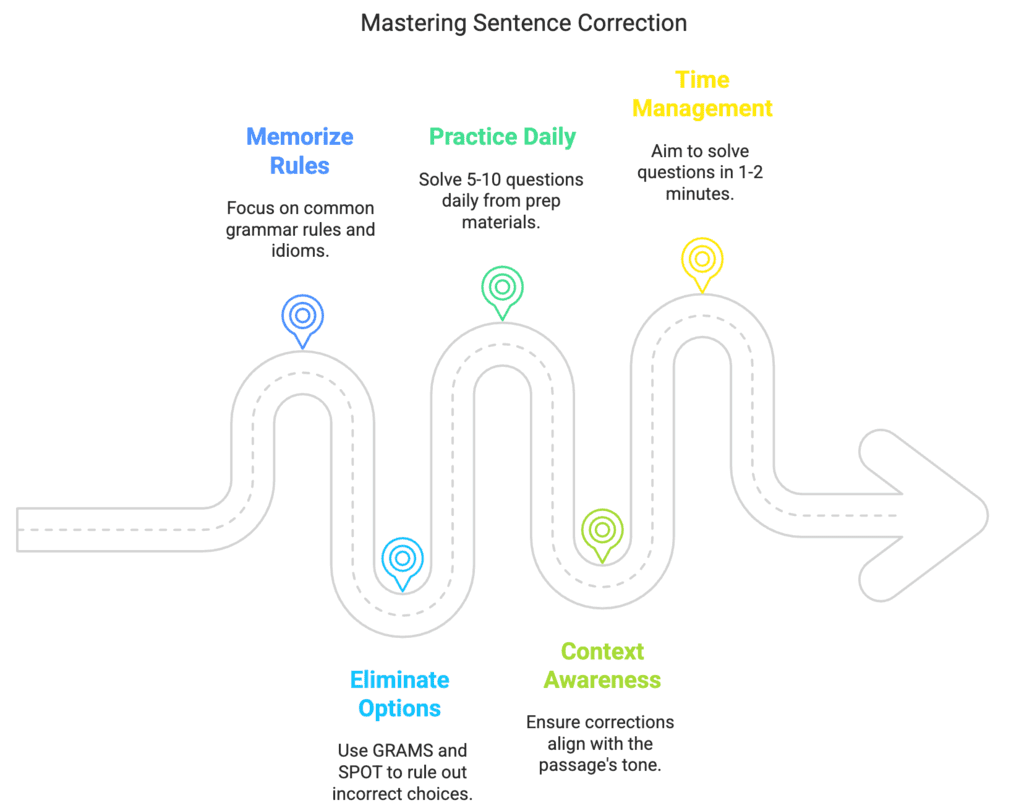Mnemonics for Sentence Correction | Verbal Ability & Reading Comprehension (VARC) - CAT PDF Download
Introduction
Sentence Correction questions require you to spot and fix errors in grammar, sentence structure, word choice, or logic. Using these mnemonics can help you approach these questions in a more organized way, making it easier to identify mistakes and improve your accuracy in correcting them.

Mnemonic 1: GRAMS - Core Checklist for Error Identification
- Grammar: Check for subject-verb agreement, pronoun errors, and tense consistency.
- Redundancy: Look for unnecessary words or repetitive ideas.
- Ambiguity: Ensure the sentence is clear and precise, with no vague pronouns or modifiers.
- Modifiers: Verify that modifiers (adjectives, adverbs) are correctly placed and refer to the right noun.
- Structure: Confirm logical flow, parallel structure, and proper punctuation.
Usage: Apply GRAMS to scan each sentence for common error types. Start with grammar rules, then check for clarity and structural issues.
Mnemonic 2: SPOT - Common Error Types
- Subject-Verb Agreement: Ensure the subject and verb match in number (singular/plural).
- Pronouns: Check for correct pronoun case (e.g., who/whom), agreement, and clear antecedents.
- Order (Modifier Placement): Misplaced or dangling modifiers should be corrected.
- Tense: Verify that verb tenses align with the sentence’s timeline.
Usage: Use SPOT to quickly identify the most frequent error categories in Sentence Correction questions.
Mnemonic 3: CLEAR - Ensuring Clarity and Precision
- Concise: Choose options that avoid wordiness or redundancy.
- Logical: Ensure the sentence makes logical sense in context.
- Exact: Select precise words (e.g., correct idioms or vocabulary).
- Agreement: Confirm agreement in number, gender, and person.
- Reference: Ensure pronouns and modifiers clearly refer to the intended noun.
Usage: After identifying errors with GRAMS or SPOT, use CLEAR to select the best correction option that is concise, logical, and precise.
Mnemonic 4: RULES - Key Grammar Rules to Remember
- Relative Pronouns: Use “who” for people, “that” for things, and “which” for non-restrictive clauses.
- Unparallel Structure: Ensure parallel structure in lists or comparisons (e.g., “reading, writing, and running”).
- Logical Comparisons: Compare similar entities (e.g., “The speed of the car is greater than that of the bike”).
- Expressions (Idioms): Memorize common idioms (e.g., “insist on,” not “insist to”).
- Subjunctive Mood: Use “were” for hypothetical situations (e.g., “If I were rich”).
Usage: Keep RULES in mind for specific grammar traps often tested in Sentence Correction.
Mnemonic 5: VERIFY - Final Validation of the Correct Option
- Validity: Ensure the corrected sentence follows all grammar rules.
- Effectiveness: Confirm the sentence conveys the intended meaning clearly.
- Readability: Check that the sentence flows naturally and is easy to understand.
- Idiomatic Correctness: Verify that idioms or phrases are used correctly.
- Fit: Ensure the corrected sentence fits the context (if provided).
- Yes/No Errors: Confirm that no new errors are introduced in the corrected version.
Usage: After selecting an answer, use VERIFY to double-check that the corrected sentence is grammatically and logically sound.
Practice Tips
- Memorise Key Rules: Focus on common grammar rules (e.g., subject-verb agreement, pronoun usage) and idioms.
- Eliminate Wrong Options: Use GRAMS and SPOT to rule out options with clear errors.
- Practice Daily: Solve 5-10 Sentence Correction questions daily from prep materials or past papers.
- Context Awareness: If the sentence is part of a passage, ensure the correction aligns with the passage’s tone and meaning.
- Time Management: Aim to solve each question in 1-2 minutes during practice to build speed.

Example Application
Sample Sentence: The committee have decided to postpones the meeting, due to their conflicting schedules.
Using GRAMS:
- Grammar: “The committee have” is incorrect (singular subject needs “has”). “Postpones” should be “postpone” (infinitive after “decided”).
- Redundancy: “Due to their conflicting schedules” could be more concise (e.g., “due to conflicting schedules”).
- Ambiguity: “Their” is ambiguous—does it refer to the committee or others?
- Modifiers: No misplaced modifiers.
- Structure: The comma before “due” is unnecessary.
Using SPOT:
- Subject-Verb: Correct “have” to “has.”
- Pronouns: Clarify “their” or remove ambiguity.
- Order: No modifier issues.
- Tense: Correct “postpones” to “postpone.”
Corrected Sentence: The committee has decided to postpone the meeting due to conflicting schedules.
Using VERIFY: The corrected sentence is valid (grammar correct), effective (clear meaning), readable (flows well), idiomatic (correct phrases), fits context, and introduces no new errors.
|
111 videos|450 docs|90 tests
|
FAQs on Mnemonics for Sentence Correction - Verbal Ability & Reading Comprehension (VARC) - CAT
| 1. What is the GRAMS mnemonic used for in sentence correction? |  |
| 2. How does the SPOT mnemonic assist in identifying common error types? |  |
| 3. What does the CLEAR mnemonic emphasize for ensuring clarity and precision in writing? |  |
| 4. What are some key grammar rules included in the RULES mnemonic? |  |
| 5. How can the VERIFY mnemonic be utilized for final validation of a sentence correction option? |  |





















